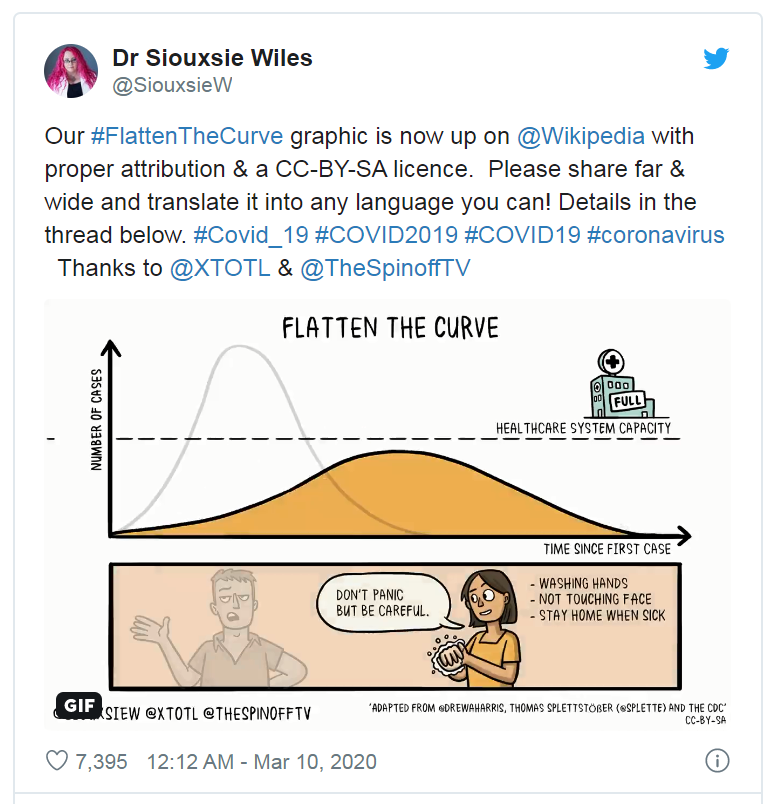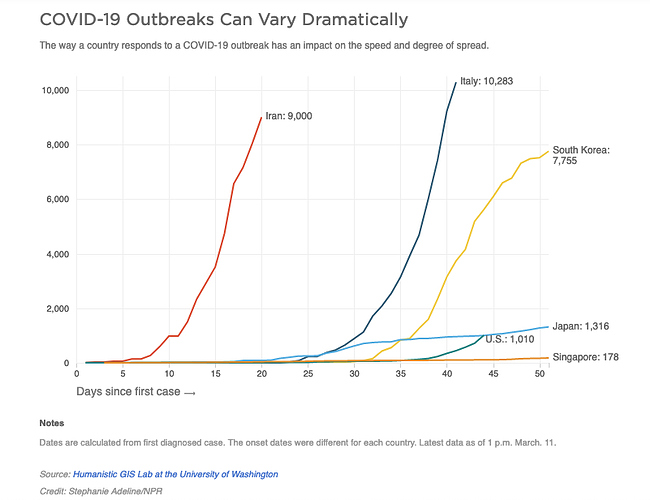WTF
My kid’s school will be closing for six weeks as of this Friday. We’re all just working from home now. 
Still looking for a good local news report on this…the emails just went out an hour ago.
This morning it was two weeks for some King County schools. I’m not sure if this is further precautions or what?
Coronavirus and the homeless: Why they’re especially at risk, ways to stop a spread ‘like wildfire’ - ABC News -
A world unprepared to handle a cooperative way to curb an out-of-control virus now at Pandemic levels. Lack of leadership, delayed responses, lack of coordination of efforts and finger pointing are all equally applied here, in the face of a world health crisis.
Help us all.
NYTimes:
A Fumbled Global Response to the Virus in a Leadership Void
President Trump has failed to work with other leaders to fashion a common response, preferring to promote his border wall over the scientific advice of his own medical experts.
In an Oval Office address on Wednesday night, he imposed a 30-day ban on travel from Europe to the United States, claiming, without evidence, that the European Union’s lax initial response had brought more cases of the virus across the Atlantic, with “a large number of new clusters” seeded by travelers from the Continent.
Mr. Trump’s secretary of state, Mike Pompeo, has taken to calling the contagion the “Wuhan virus,” vilifying the country where it originated and complicating efforts to coordinate a global response.
The same denigration of science and urge to block outsiders has characterized leaders from China to Iran, as well as right-wing populists in Europe, which is sowing cynicism and leaving people uncertain of whom to believe. Far from trying to stamp out the virus, strongmen like President Vladimir V. Putin of Russia and Crown Prince Mohammed bin Salman of Saudi Arabia have seized on the upheaval it is causing as cover for steps to consolidate their power.Yet it is too simple to lay all this at Mr. Trump’s door, or on world leaders collectively. Part of the problem is simply the fiendish nature of the pathogen.
Coronavirus has resisted the tools that countries have brought to bear against previous global scourges. Mysterious in its transmission and relentless in its spread, it has led countries to try wildly divergent responses. The lack of common standards on testing, on the cancellation of public gatherings and on quarantines have deepened the anxiety of people and eroded confidence in their leaders.
The simultaneous shocks to supply and demand — shuttered iPhone factories in China; empty gondolas in Venice; and passengers abandoning cruises, hotels and airlines everywhere else — is a new phenomenon that may not respond to the weapons that governments wielded against the dislocation that followed the Sept. 11, 2001, terrorist attacks and the financial crisis of 2008.
CNN tells it like it is. Banner headlines like this are reserved for the gravest news.
President Donald Trump set out to steady a rattled nation and a diving economy, but instead sowed more confusion and doubts that he is up to handling the fast-worsening coronavirus crisis.
Trump spoke to the nation at a fearful moment, when the rhythms of everyday American life are starting to shut down – with schools closing, the NBA suspended, hospitals on high alert and movie icon Tom Hanks saying he and his wife have the disease.
“The virus will not have a chance against us. No nation is more prepared or more resilient than the United States,” the President said, before painting a rosy picture of an economy that is already taking a beating from the virus fallout. The President unveiled several measures to help on that score, to help workers who have to self-isolate and hard-hit by shutdowns, though his call for a payroll tax cut is not popular in Congress.
Trump’s big announcement for keeping the virus at bay – what he said was a 30-day ban on travel to the US by Europeans and restrictions on cargo – was immediately engulfed in confusion.
The President later rushed to clarify on Twitter that he was stopping travel and not trans-Atlantic trade in goods, and officials said his plan did not apply to Americans or US permanent residents – though such travelers would face mandatory quarantines.
Trump also caused a muddle when he said he had convinced health insurance providers to waive all copayments for coronavirus treatments.
A White House official later said the President had meant to say that the copayments would be waived for coronavirus tests – but would still apply to treatments for the disease.
Sowing confusion
The confusion was symptomatic of an administration that has often struggled to frame detailed policies and present them coherently. Trump’s top assignment on Wednesday was to show that he was in charge and that he appreciated, finally, the grave nature of the weeks that lie ahead. But the confusion over the travel ban turned his speech into something of a debacle and may up exacerbating uncertainty over his leadership.
And his travel ban announcement was made apparently without consultation with the travel industry or US allies and seems set to cause massive disruption that will deepen already cascading economic damage unleashed by the crisis.
The move could cause mass cancellation of trans-Atlantic flights, which could throw the aviation industry into an moment of existential challenge. It is likely to do nothing to quell investor panic after Wall Street on Wednesday dipped into a bear market. For example, Dow Futures plunged more than 1,000 points after Trump’s speech.
“This is not a financial crisis. This is just a temporary moment of time that we will overcome together as a nation and as a world,” Trump said in his address.
On a more fundamental level, the travel ban plan raised basic questions about the President’s understanding of a crisis he has minimized, blamed on Democrats and predicted will just go away soon.
Department of Homeland Security guidance suggested the restrictions exempted US nationals and permanent residents, who would face quarantine when they came home. And the President did not explain why his ban did not include citizens of the UK – where the virus has also taken root.
But the biggest problem facing the US is not more cases of coronavirus coming from Europe – it is that the disease has taken root on US soil itself by community spread.
Pressing issues now revolve around how Americans should respond to the situation and to what extent they should change their daily patterns. Trump did advise halting nonessential visits to care homes for the elderly – the highest risk group from the virus.
But he didn’t explain how he would alleviate what health officials fear will be a crowding of hospitals, the continuing lack of proper testing or the coming strain on resources such as breathing machines needed to keep the sickest patients alive.
He argued that the threat was still “very low” for all but the old and infirm, on a day when one of his top public health officials, Dr. Anthony Fauci, predicted the current scenario – with more than 1,200 people sick in the US and 38 dead, is “going to get worse.”
Trump speech likely to split the nation
To Trump’s supporters, his address likely came across as a decisive and bold move to face up to a national challenge.
But to critics it followed a familiar playbook – as he blamed others for the crisis, basked in self-congratulation and xenophobia, and misled the country about his actions so far.
"This is the most aggressive and comprehensive effort to confront a foreign virus in modern history," Trump said, misrepresenting his own and his administration’s catalog of missteps.
The President did not mention, for example, the shortage of testing kits, which means officials cannot even get a strong read on how far the disease has spread across the nation.
Presidents use Oval Office addresses in moments of extremis, to bind Americans together to confront a challenge that threatens their collective security.
But Trump’s toneless, almost resentful address as he faces a challenge from outside that could threaten his reelection hopes is unlikely to fulfill the soaring mission of the presidency.
His central remedy – blaming China, where the crisis was spawned, and Europe for becoming afflicted with it – was consistent with his political mantra of demonizing foreigners.
The idea that a virus that affects all humans and is a naturally occurring force was some kind of foreign-brewed threat sent to attack Americans is in itself staggering in its conception.
The President did announce a raft of measures to support businesses and individuals with tax relief and low interest rates as the virus tightens its grip on the US.
But Trump’s plan to self-isolate the US from Europe appears to be a case of closing the stable door after the horse has bolted – the virus is already here and infecting more Americans by the day.
Here’s hoping that the CDC is focused on “flattening the curve” as explained in this article. Too bad Trump eliminated the Pandemic Response team back in 2018 that would have been standing by, ready to aggressively roll out this strategy. We can each do our part, though, to flatten the curve and help protect our hospital system from becoming overwhelmed.
The main uncertainty in the coronavirus outbreak in the United States now is how big it will get, and how fast. The Centers for Disease Control and Prevention’s Nancy Messonnier told reporters on March 9, “many people in the US will at some point, either this year or next, get exposed to this virus.”
According to infectious disease epidemiologist Marc Lipsitch at Harvard, it’s “plausible” that 20 to 60 percent of adults will be infected with Covid-19 disease. So far, 80 percent of cases globally have been mild, but if the case fatality rate is around 1 percent (which several experts say it may be), a scenario is possible of tens or hundreds of thousands of deaths in the US alone.
Yet the speed at which the outbreak plays out matters hugely for its consequences. What epidemiologists fear most is the health care system becoming overwhelmed by a sudden explosion of illness that requires more people to be hospitalized than it can handle. In that scenario, more people will die because there won’t be enough hospital beds or ventilators to keep them alive.
A disastrous inundation of hospitals can likely be averted with protective measures we’re now seeing more of — closing schools, canceling mass gatherings, working from home, self-quarantine, avoiding crowds — to keep the virus from spreading fast.
Epidemiologists call this strategy of preventing a huge spike in cases “flattening the curve,” and it looks like this:
Christina Animashaun/Vox“Even if you don’t reduce total cases, slowing down the rate of an epidemic can be critical,” wrote Carl Bergstrom, a biologist at the University of Washington in a Twitter thread praising the graphic, which was first created by the CDC, adapted by consultant Drew Harris, and popularized by the Economist. The chart has since gone viral with the help of the hashtag #FlattenTheCurve.
Flattening the curve means that all the social distancing measures now being deployed in places like Italy and South Korea, and on a smaller scale in places like Seattle and Santa Clara County, California, aren’t so much about preventing illness but rather slowing down the rate at which people get sick.
On Thursday, the CDC posted new guidance for people over age 60 and people with chronic medical conditions — the two groups considered most vulnerable to severe pneumonia from Covid-19 — to “avoid crowds as much as possible.”
“If more of us do that, we will slow the spread of the disease,” Emily Landon, an infectious disease specialist and hospital epidemiologist at the University of Chicago Medicine, told Vox. “That means my mom and your mom will have a hospital bed if they need it.”
So even if you’re young and healthy, it’s your job to follow social distancing measures to avoid spreading it to others, and keep the epidemic in slow motion. “The more young and healthy people are sick at the same time, the more old people will be sick, and the more pressure there will be on the health care system,” said Landon.
Hospitals filled with Covid-19 patients won’t just strain to care for those patients — doctors may also have to prioritize them over others. “Right now there’s always a doctor available when you need one, but that may not be the case if we’re not careful,” says Landon.
Staying home helps prevent the US health system from being overloaded
At this point, with the virus spreading in America, the top priority is making sure the health care system avoids being flooded with very sick patients who need ventilators and intensive care.
“From a US standpoint, you want to prevent any place from becoming the next Wuhan,” says Tom Frieden, who led the CDC under President Barack Obama. “What that means is even if we’re not able to prevent widespread transmission, we want to prevent explosive transmission and anything that overwhelms the health care system.”
Remember, America’s hospitals and doctors are already dealing with their usual caseloads during a pretty bad flu season. Now they have to be ready to handle any Covid-19 patients who come their way.
There are serious concerns about the US system’s capacity to handle a severe outbreak. Covid-19 is a respiratory illness and in its most serious stages can require patients with pneumonia to be put on a ventilator. But there might not be enough ventilators to meet that need if the outbreak becomes too widespread.
The Johns Hopkins Center for Health Security reported in 2018 that, according to US government estimates, about 65,000 people in the United States would require ventilation in an outbreak similar to the flu pandemics of 1957-1958 (which killed 116,000 people in the US) and 1968 (which killed 100,000 Americans).
The maximum number of ventilators that could be put in the field in the United States is about 160,000. So under those scenarios, there would theoretically be enough capacity to meet the need.
But if the coronavirus outbreak gets worse, we could quickly run out. In a situation more similar to the Spanish flu pandemic (675,000 dead in the US), about 742,500 people in the United States would require ventilation, according to government estimates. We don’t have that many.
The health system is much more than ventilators, of course, and the concerns about capacity apply to the rest of it, too. As HuffPost’s Jonathan Cohn reported, US hospitals have about 45,000 beds in their intensive care units. In a moderate outbreak, about 200,000 patients may need to be put in the ICU, but under a more severe outbreak, it could be nearly 3 million.
And while all 3 million of them would likely not need treatment at the same time, we again need to account for the ICU patients hospitals already had before coronavirus arrived, as Cohn noted:
On the one hand, those are total numbers, for the duration of the epidemic. Even under the most dire scenario, it’s unlikely that 2.9 million people would need ICU beds all at once. On the other hand, ICU beds in the U.S. are already pretty full, thanks to the normal crush of patients with influenza and other major medical problems.
As a result, hospitals are routinely at capacity, forcing backups of patients “boarding” in emergency departments for hours or even days, waiting on the beds there until inpatient slots become available. And that’s before any influx from COVID-19.
Hospitals are already doing what they can — rationing surgical masks, preparing to stand up temporary facilities, etc. — and they will take more extreme measures if they can’t handle all the people with Covid-19 plus their more routine patients.
But one thing people can do to help is stay home if they are feeling unwell and especially if they received a formal Covid-19 diagnosis and advice to self-quarantine. That way, the US health care system can focus on the patients who really need it during this outbreak.
Trump’s coronavirus travel ban excludes the countries where he has golf courses struggling for business
https://twitter.com/LorcanRK/status/1238064261705928705
Patients with the new coronavirus keep the pathogen in their respiratory tract for as long as 37 days, a new study shows
In other, personal, news, this is the time of year I get my “feb flu”, cedar fever, a severe allergy.
Symptoms: congestion, cough, fever, aching joints, runny nose.
Woke up with a worsening cough & full chest.
I work from home.
Tomorrow I get tested for coroanavirus to be safe… if they have tests. Wish me luck.
Best of luck to you, I hope it’s just allergies.
There is every chance it is, but my wife works at the transportation hub for a major multi-national company that has people coming and going from all over. Though they’ve taken precautions, the more we learn, the less it seems like those precautions are enough.
I just checked my temp and no actual fever, so that’s a good sign, and hopefully it’s just my usual seasonal ick, but the symptoms are so similar, there’s no way I’d know. Better safe than sorry.
In other news:
https://twitter.com/LorcanRK/status/1238064261705928705
But, you know, his golf courses.
Zhao Lijian is the current deputy director of the Foreign Ministry Information Department in China. Here he is taking uncertainty over whether some deaths labeled “influenza” could have been from the coronavirus and using it for #gaslighting to accuse the U.S. army of bringing the virus TO Wuhan.
Just as the right is claiming the virus to be man-made and calling it a “foreign” virus and “Chinese” virus and so on to blame China, as if that makes a difference as to how dangerous it is, so China, a totalitarian regime, is doing the same. Two autocratic governments, both using propaganda.
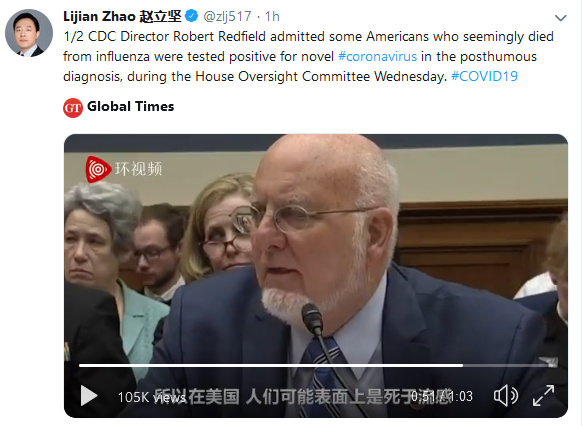
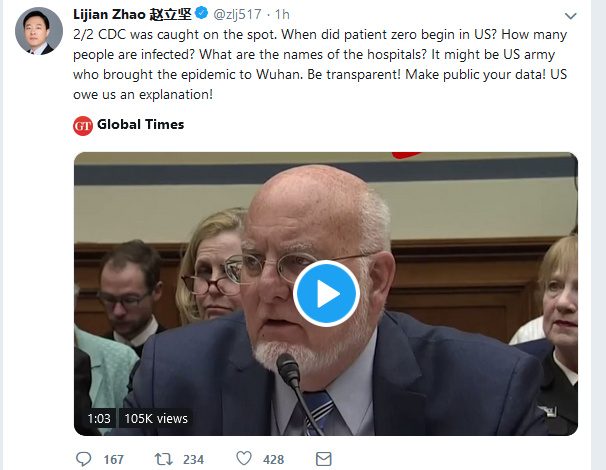
Incidentally, the way I found out about that propaganda post from the Chinese minister?
A mysterious Chinese account responded to a post of mine with a screenshot of the second post. I don’t think they got what they intended out of that, since I looked it up and called it out.
Apparently Tom Cotton is angry that the coronavirus made him close his office and just threatened repercussions on “those who inflicted it on the world.”

Ditto…
Rep Katie Porter came armed to discuss what needs to be covered by CDC now, at the House Oversight hearing this morning. She’s bringing it.
Q & A with Rep Katie Porter and CDC Redfeld
Video 
Video 
https://twitter.com/jonlovett/status/1238152577369268224?s=20
When we hear all these false or misleading bits of information, brought to you by Charlie Sykes, political commentator who is currently editor-in-chief of the website The Bulwark, you wonder who you gonna believe. #DisinformationCentral
https://twitter.com/SykesCharlie/status/1238132410870620161?s=20
https://twitter.com/SykesCharlie/status/1238132414272208901?s=20
https://twitter.com/SykesCharlie/status/1238132415673106433?s=20
https://twitter.com/merylnyc/status/1238156224098709505
https://twitter.com/nadjaguyot/status/1238116973860577281
The GOP is holding up a bill because they want to charge for the coronavirus vaccine.
Coronavirus emergency bill stalled over vaccine cost concerns
Democrats are insisting the spending package include significant funding to purchase large amounts of coronavirus diagnostics.
Republicans blocking coronavirus bill that limits how much drugmakers can charge for vaccine: report
A vaccine for coronavirus is in the works, but experts suggest it is at least a year away from becoming available
https://twitter.com/markberman/status/1238162210846838785?s=20
Hong Kong and Singapore were hit early with the coronavirus. But each now has fewer than 200 cases, while France, Germany and Spain, which were hit late, all have more than 10 times that number.
Three weeks ago, Italy had only three cases. Now it has more than 10,000.
These dramatic differences show that how governments respond to this virus matters, says Mike Ryan, the World Health Organization’s head of emergencies.
“Hope is not a strategy,” says Ryan, who is an epidemiologist. "We are still very much in the up cycle of this epidemic."
Supreme Court closes 
The Supreme Court will be closed to the public until further notice amid the coronavirus pandemic, a spokesperson said Thursday.
The building will remain open for “official business,” the spokesperson said. The next oral arguments are scheduled to take place on March 23.
Next will be Congress, right? THey are looking for new locations I am hearing.
This Brit comedy is years old - but it probably typifies the discussions in the WH, #10, and other govt’s around the world.
Taking issue with Trump claim
Republican and Democratic senators left their closed briefing furious over the US failure to ensure there is widespread testing – and contradicted President Donald Trump’s claims that anyone can get tested when they want to get tested.
“Our system has just not been up to snuff and I think a lot of people are frustrated by it,” said Republican Sen. Mitt Romney of Utah. “I’m one of them.”
GOP Sen. James Lankford of Oklahoma, an ally of Trump, told CNN that the President “should stop saying” that anyone can get a COVID-19 test if they want one.
…
Senate recess canceled
Senate Majority Leader Mitch McConnell announced on Thursday that the Senate will be in session next week to work on coronavirus legislation and will not go on a previously scheduled recess. His comments came after an outpouring of lawmakers – many of them Republicans – called to cancel the weeklong break.
"The Senate will be in session next week," McConnell, a Kentucky Republican, wrote on Twitter. “I am glad talks are ongoing between the Administration and Speaker Pelosi. I hope Congress can pass bipartisan legislation to continue combating the coronavirus and keep our economy strong.”
House Minority Leader Kevin McCarthy said earlier Thursday at his weekly press conference that Democrats and Republicans should negotiate to reach a consensus, calling for members to stay in town to get it done instead of heading home.
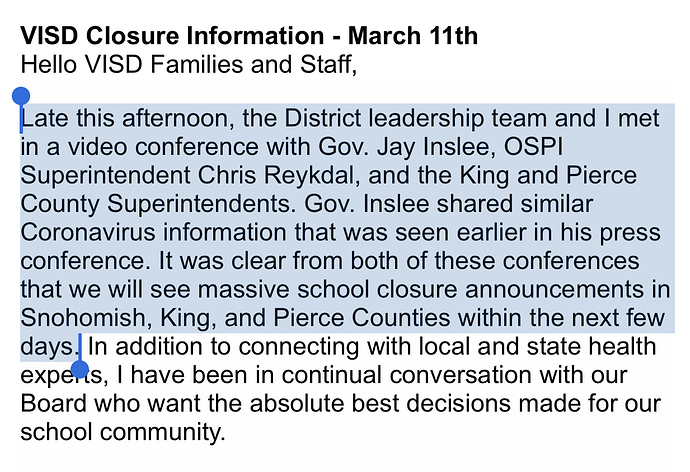
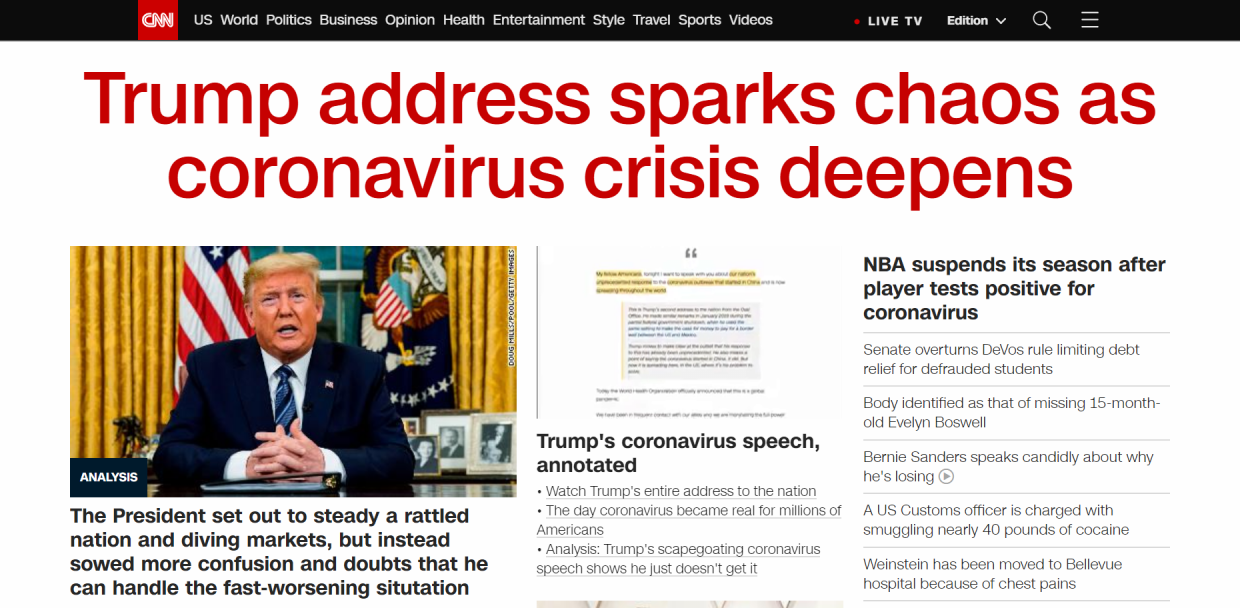
:no_upscale()/cdn.vox-cdn.com/uploads/chorus_asset/file/19780273/flattening_the_curve_final.jpg)
